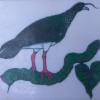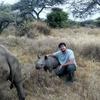Wildlife crime is one of the greatest challenges facing conservation, and one of the conservation tech world's biggest areas of innovation. With new ideas and solutions constantly being put forth to track and protect species targeted by poachers, manage protected areas and support rangers, and combat the growing online market for illegal wildlife products, the engineers and conservationists working to solve wildlife crime's many challenges rely on tools like machine learning, biologging, camera traps, acoustic monitoring, drones, mobile apps, and more.
This wide variety of overlapping technology makes our Wildlife Crime group a potential melting pot for many of our other communities, and makes it an especially exciting place to find collaborators working in different tech spheres to meet a common goal. Whether you're a camera trap expert looking for information on thermal vision to spot potential poachers, a machine learning expert with the skills to analyze acoustic data for gunshots, or a protected area manager seeking the latest integrated mobile tools, this group can connect you with the right members of our community!
Below, you'll find WILDLABS resources and conversations to help you understand how different technologies are being put to work in the fight against wildlife crime, and what conservation tech practitioners need for these tools to be effective.
Three Tutorials and Videos for Beginners:
- How do I use AI to fight wildlife crime? | Lily Xu, Tech Tutors
- WWF Wildlife Crime Technology Project | Eric Becker, Virtual Meetups
- SmartParks | Laurens de Groot, Virtual Meetups
Three Forum Threads for Beginners:
- Snare detection technologies | Rachel Kramer
- Tools for conservation management | Chris Muashekele
- Looking for Intelligence Database Software | Dexter Oelrichs
Three Articles for Beginners:
- Using AIS data to investigate the world's fishing ports, Max Schofield
- How do Wildlife Crime Experts view Remote Sensing Technologies used to Combat Illegal Wildlife Crime?, Isla Duporge
- Metal Detecting Sensors for Anti-Poaching, Sam Seccombe
Join this group now to get to know our community and start discussing solutions and ideas together!
Header photo: © Frank af Petersens/Save the Elephants
No showcases have been added to this group yet.
Greenhood Nepal
- 0 Resources
- 0 Discussions
- 5 Groups
I run a small consulting company, Simeone Consulting, LLC, that provides research, data-driven analysis, technical expertise, and writing related to the production, consumption, and international trade of natural resources.
- 0 Resources
- 4 Discussions
- 4 Groups
- 0 Resources
- 0 Discussions
- 13 Groups
Botswana Predator Conservation Trust



- 0 Resources
- 85 Discussions
- 10 Groups
I work in conservation on integrating the technology out there for custom solutions for partners.
- 0 Resources
- 0 Discussions
- 22 Groups
Passionate about wildlife and impact investment with an academic, research and practitioner background in environmental science, environmental law and green criminology pursued in Central America, China, Tanzania and the United Kingdom I am driven to decolonise the research on c
- 1 Resources
- 0 Discussions
- 9 Groups
Dedicated wildlife conservationist with over three years of hands-on experience in field research and conservation. Through extensive fieldwork i developed a strong foundation in various conservation techniques, including camera trap deployment, plant inventory methods.
- 0 Resources
- 0 Discussions
- 9 Groups
- @Venance
- | Mr
As a wildlife conservationist, I am deeply committed to the Ecology and Community Development. I help communities balance conservation with livelihoods, promoting beekeeping with the motto “Shusha Shoka, Pandisha Mzinga (Drop the Axe, Raise the Hive).
- 0 Resources
- 0 Discussions
- 8 Groups
Movement Ecologist studying the where, why, and how animals move throughout our world. Current work is investigating the movement and energetics of large neotropical bats in a changing environment with ephemeral resources.



- 0 Resources
- 23 Discussions
- 22 Groups
- @matt_hron
- | He/Him
Wildlife Protection Solutions (WPS)
Product Manager at Wildlife Protection Solutions



- 0 Resources
- 8 Discussions
- 8 Groups
University of British Columbia
Postdoc at UBC, exploring how drones enhance wildlife conservation using thermal cameras & AI tools to refine monitoring of large mammal populations in Canada & compare these approaches to traditional methods.
- 0 Resources
- 0 Discussions
- 7 Groups
Asst. Prof @ MIT with research at the intersection of computer vision, biodiversity monitoring, conservation, and sustainability.



- 4 Resources
- 15 Discussions
- 5 Groups
Careers
The Senior Conservation Technology Specialist will be responsible for providing technical advice and capacity development to GWP project teams on conservation technology, distilling challenges and lessons from project...
22 September 2022
Article
An update on Ceres Tags products that are being used in conservation
22 August 2022
Article
Ceres Tag sends just in time alerts and GPS location to have the power to track and trace.
22 July 2022
This position will support WCS’ training and capacity development work, specifically by supporting the global capacity building efforts of the Learning and Leadership for Conservation (LLC) program, including CLP and...
23 June 2022
Julia Martínez Pardo et al., Published in Biological Conservation
4 June 2022
Authors: Ritwik Kulkarni, Enrico Di Minin
29 May 2022
Mongabay article on the recently launched Centre for Wildlife Forensics in Singapore, noting their successes so far in catching wildlife traffickers and uncovering trafficking routes
29 May 2022
Our first WILDLABS Editorial Series is now available for download! Read the full Technical Difficulties collection and explore stories of challenges, failures, and lessons learned from the conservation tech community....
19 January 2022
According to a news article published by Yahoo on September 28th, 2021, all Online technology companies in the Coalition to End Wildlife Trafficking Online reported removing or blocking over 11.6 million listings and...
6 December 2021
In her contribution to the Technical Difficulties Editorial Series, Christie Sampson shares how the devastating experience of losing collared elephants to an unexpected poaching threat lead to an improved understanding...
3 November 2021
In their three-part interview from our new series Technical Difficulties, Colby Loucks and Eric Becker share the failures they've encountered and learned from throughout six years of working on the WWF-US Wildlife Crime...
27 October 2021
In their three-part interview from our new series Technical Difficulties, Colby Loucks and Eric Becker share the failures they've encountered and learned from throughout six years of working on the WWF-US Wildlife Crime...
20 October 2021
September 2025
November 2023
event
42 Products
1 R&D Projects
42 Organisations
Recently updated products
Recently updated R&D Projects
Recently updated organisations
| Description | Activity | Replies | Groups | Updated |
|---|---|---|---|---|
| Hi Gautam, I think the best way is have them read the thread, and then get back to me with questions - I can then respond on a case-by-case basis. Our website is here:... |
|
Wildlife Crime | 9 years 6 months ago | |
| Hi All, Rachel has asked that I tell you a bit about who we are and what we do and how we think we can help this group. We are... |
|
Wildlife Crime | 9 years 6 months ago | |
| This post made me wander whether we could employ social media listening tools to identify illegal wildlife trade hotspots, levels, changes in ... |
|
Wildlife Crime | 9 years 6 months ago | |
| The Journal of Animal Ecology with the Journal of Applied Ecology and Methods in Ecology and Evolution have published a... |
|
Wildlife Crime | 9 years 6 months ago | |
| Watch streaming footage here of John Amos, President of Sky Truth, speaking on Cheap Space, DIY Imaging and Big... |
|
Wildlife Crime | 9 years 9 months ago |
Neotropical Migratory Bird Conservation Act grants via USFWS
8 November 2016 12:00am
How do Wildlife Crime Experts view Remote Sensing Technologies used to Combat Illegal Wildlife Crime?
7 November 2016 12:00am
Zoohackathon: 'END LOOP - Coding to end wildlife trafficking'
22 September 2016 12:00am
Tiger poacher likely convicted due to camera trap evidence
23 November 2015 7:24pm
10 August 2016 4:21pm
That paper is available on Sci Hub.
Perspectives from the World Ranger Congress
10 August 2016 12:00am
GPS trackers in trafficked animal parts
26 July 2016 7:24pm
Ivory ID using portable molecular sensors?
1 July 2016 4:01pm
12 July 2016 7:37pm
There are so few details on the link that it is not possible to judge whether that particualr hardware will be any use for anything. I suspect that it used near infra-red which has some applications for bulk anayses of foods but I doubt that it could distinguish different types of animal ivory. It might be able to discriminate between vegetable and animal ivory.
26 July 2016 4:40pm
Thanks, @Peter+Apps . I reached out to ConsumerPhysics for more information. They said that scanning animal ivories for identification purposes is likely to be feasible with SCiO and that others may be considering this application as well.
They confirmed that SCiO uses NIR spectroscopy for classification between different substances, providing that the molecular fingerprints are different enough from each other. It sounds like they did a basic feasibility test that "showed promise in classifying ivory samples from different kinds of animals - elephant, mammoth, hippopotamus and walrus, as well as plastic mock-ivory samples. The corresponding molecular sensing models and applications will have to be developed further for better insight. This may be developed in the future either by us or by the SCiO developer community using the SCiO Development Toolkit, which allows users to create models and apps."
They suggested that a user would need to take two things into consideration when working toward this application: "First, as SCiO’s detection threshold varies by material, and is typically 0.1%-1%, some micro-nutrients will not be detectable. This requires further research. In addition, it should be noted that building the database for such an application requires access to samples and their chemical characteristics."
More info on DevKit SDK is online here: https://www.consumerphysics.com/myscio/developers/ and here: https://www.youtube.com/watch?v=6wDLSF0ZkIA. I have no experience with this technology and no connection to ConsumerPhysics, but it sounds interesting.
I think this could be a good research project for someone in the WILDLABS community. With the scope of our network, gaining access to samples should not be a challenge.
26 July 2016 7:06pm
It sounds like @David+Baisch at Conservation X Labs just ordered a SCiO spec and developer's kit to test its sensitivity. They're interested in seeing whether the device can be used to differentiate beteween tree species in treated and untreated wood products. Looking forward to learning more about that process!
Video: Discover the SMART Approach
 The SMART Partnership
The SMART Partnership
20 July 2016 12:00am
New rhino poaching report out
11 July 2016 1:36pm
Can Drones Live up to the Hype?
8 July 2016 12:00am
Wildlife Crime Tech Challenge Accelerator Bootcamp
24 June 2016 12:00am
TEAM Network and Wildlife Insights
28 April 2016 12:00am
Wildlife Crime Apps
13 April 2016 3:46pm
The Spatial Monitoring and Reporting Tool (SMART)
15 March 2016 12:00am
Disruptive Technology: Embracing the Transformative Impacts of Software on Society
10 March 2016 12:00am
15th International Elephant & Rhino Conservation and Research Symposium
4 March 2016 12:00am
Bringing Conservation Technology to Life
17 February 2016 12:00am
JIGZAW and Mars Omega, an introduction
2 February 2016 3:17pm
3 February 2016 4:44am
Thanks Anthony - what is the best way to introduce others to your product and solutions? I live in Kenya - can you disclose who you are working with here?
With regards to a scale up partner, can you provide a few more details on what you are looking for?
Gautam!
3 February 2016 10:08am
Hi Gautam,
I think the best way is have them read the thread, and then get back to me with questions - I can then respond on a case-by-case basis. Our website is here: http://www.marsomega.com. We have not yet updated it to make public our involvement in countering wildlife crime, but that will be done shortly.
On disclosure, Hamish is actually in Kenya from tomorrow, and he is talking to our Kenyan partners to make sure they are happy to have this information made more freely available. We necessarily are being very discreet.
On scaling - as one of the 16 Prize WInners in the Wildlfe Criem Tech Challenge, we have only just started talking to the competition sponsors about acceleration and scaling. Once we have established that process and have more information ourselves, I will be happy to discuss this further.
Best regards,
Anthony
JIGZAW - information collection and use
3 February 2016 9:55am
Report outlines 2016's most pressing conservation issues
3 February 2016 12:00am
Illegal wildlife sales on social media
4 January 2016 3:56pm
26 January 2016 4:14pm
This post made me wander whether we could employ social media listening tools to identify illegal wildlife trade hotspots, levels, changes in attitude towards IWT products etc.? Perhaps already being done? Here's some case studies from Brandwatch of how brands are using social media listening: https://www.brandwatch.com/case-studies/
Real-time anti-poaching tags to prevent imminent species extinctions?
22 January 2016 2:49pm
Wildlife Crime Tech Challenge: Winners Announced!
22 January 2016 12:00am
The Impact of the Internet of Things
10 December 2015 12:00am
Gaming for Good: Minecraft and Quiz Up
3 December 2015 12:00am
Harnessing Big Data to Combat Illegal Wildlife, Timber and Fisheries Trade
 Rachel Kramer
and 2 more
Rachel Kramer
and 2 more
26 November 2015 12:00am
Technology for Traceability
 Daniel Brizuela
and 1 more
Daniel Brizuela
and 1 more
26 November 2015 12:00am
Gaming for Good: Runescape and Angry Birds
25 November 2015 12:00am
Nov 18th: Cheap Space, DIY Imaging and Big Data
9 November 2015 2:36pm
What is eDNA?
2 November 2015 12:00am
1 August 2025 10:14am






























8 August 2016 11:16am
A new paper in Biological Conservation assesses the efficacy of camera trapping as a tool for increasing detection rates of wildlife crime in tropical protected areas:
The future of biodiversity in Asia is increasingly dependent on networks of effective protected areas. Three wildlife sanctuaries of the Bangladesh Sundarbans are typical examples of protected areas where detection and monitoring of threats is difficult due to low densities of patrol staff and low frequency of patrolling relative to the area that requires monitoring. The aim of this study was to use camera traps to quantify: 1) the levels of different types of illegal human activities (IHA), 2) spatio-temporal variation in illegal human activities, and 3) what proportion of camera trap records can be used to identify perpetrators. Each photograph was categorized as either illegal human activity (IHA) or legal human activity (LHA) based on interpretation of the particular human activity and equipment observed in photograph. For IHA, infraction type was based on the Bangladesh Wildlife (Conservation and Security) Act 2012. A total of 914 unique human activity events were recorded (872 IHA and 42 LHA) in camera trap photos over a total of 1039 trap nights. The best model suggests that during spring tide 91% of camera trapped locations in the West Sanctuary had IHA occurring in them during the survey period, while 84% and 74% locations had IHA in the South Sanctuary and East Sanctuary respectively. Camera trapping in remote areas can potentially help protected area managers to increase rates of detection of IHA in their conservation landscapes and increase rates of arrests and prosecutions by providing appropriate supporting evidence.
I'm interested to hear from the community on this one - are you using camera traps for purposes other than wildlife monitoring?